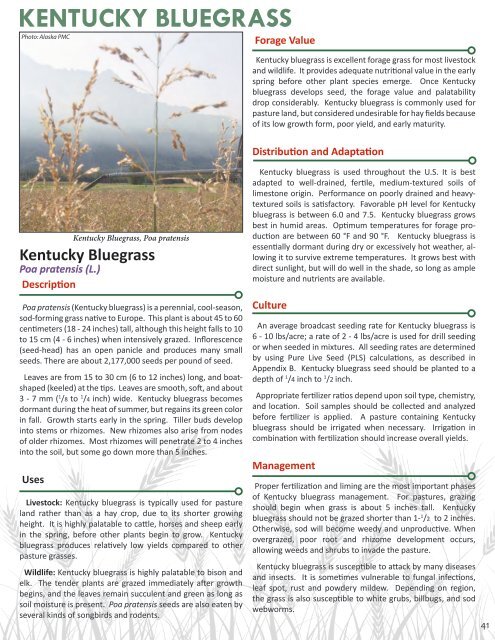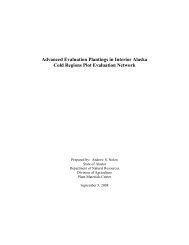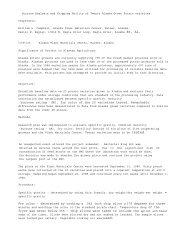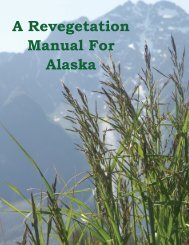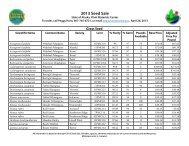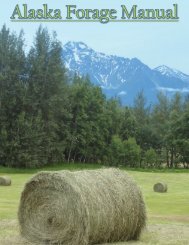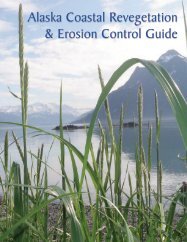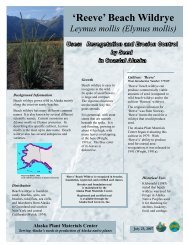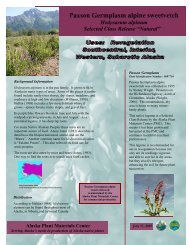Alaska Forage Manual - Alaska Plant Materials Center - State of ...
Alaska Forage Manual - Alaska Plant Materials Center - State of ...
Alaska Forage Manual - Alaska Plant Materials Center - State of ...
You also want an ePaper? Increase the reach of your titles
YUMPU automatically turns print PDFs into web optimized ePapers that Google loves.
KENTUCKY BLUEGRASS<br />
Photo: <strong>Alaska</strong> PMC<br />
<strong>Forage</strong> Value<br />
Kentucky bluegrass is excellent forage grass for most livestock<br />
and wildlife. It provides adequate nutritional value in the early<br />
spring before other plant species emerge. Once Kentucky<br />
bluegrass develops seed, the forage value and palatability<br />
drop considerably. Kentucky bluegrass is commonly used for<br />
pasture land, but considered undesirable for hay fields because<br />
<strong>of</strong> its low growth form, poor yield, and early maturity.<br />
Distribution and Adaptation<br />
Kentucky Bluegrass<br />
Poa pratensis (L.)<br />
Description<br />
Kentucky Bluegrass, Poa pratensis<br />
Poa pratensis (Kentucky bluegrass) is a perennial, cool-season,<br />
sod-forming grass native to Europe. This plant is about 45 to 60<br />
centimeters (18 - 24 inches) tall, although this height falls to 10<br />
to 15 cm (4 - 6 inches) when intensively grazed. Inflorescence<br />
(seed-head) has an open panicle and produces many small<br />
seeds. There are about 2,177,000 seeds per pound <strong>of</strong> seed.<br />
Leaves are from 15 to 30 cm (6 to 12 inches) long, and boatshaped<br />
(keeled) at the tips. Leaves are smooth, s<strong>of</strong>t, and about<br />
3 - 7 mm ( 1 /8 to 1 /4 inch) wide. Kentucky bluegrass becomes<br />
dormant during the heat <strong>of</strong> summer, but regains its green color<br />
in fall. Growth starts early in the spring. Tiller buds develop<br />
into stems or rhizomes. New rhizomes also arise from nodes<br />
<strong>of</strong> older rhizomes. Most rhizomes will penetrate 2 to 4 inches<br />
into the soil, but some go down more than 5 inches.<br />
Uses<br />
Livestock: Kentucky bluegrass is typically used for pasture<br />
land rather than as a hay crop, due to its shorter growing<br />
height. It is highly palatable to cattle, horses and sheep early<br />
in the spring, before other plants begin to grow. Kentucky<br />
bluegrass produces relatively low yields compared to other<br />
pasture grasses.<br />
Wildlife: Kentucky bluegrass is highly palatable to bison and<br />
elk. The tender plants are grazed immediately after growth<br />
begins, and the leaves remain succulent and green as long as<br />
soil moisture is present. Poa pratensis seeds are also eaten by<br />
several kinds <strong>of</strong> songbirds and rodents.<br />
Kentucky bluegrass is used throughout the U.S. It is best<br />
adapted to well-drained, fertile, medium-textured soils <strong>of</strong><br />
limestone origin. Performance on poorly drained and heavytextured<br />
soils is satisfactory. Favorable pH level for Kentucky<br />
bluegrass is between 6.0 and 7.5. Kentucky bluegrass grows<br />
best in humid areas. Optimum temperatures for forage production<br />
are between 60 °F and 90 °F. Kentucky bluegrass is<br />
essentially dormant during dry or excessively hot weather, allowing<br />
it to survive extreme temperatures. It grows best with<br />
direct sunlight, but will do well in the shade, so long as ample<br />
moisture and nutrients are available.<br />
Culture<br />
An average broadcast seeding rate for Kentucky bluegrass is<br />
6 - 10 lbs/acre; a rate <strong>of</strong> 2 - 4 lbs/acre is used for drill seeding<br />
or when seeded in mixtures. All seeding rates are determined<br />
by using Pure Live Seed (PLS) calculations, as described in<br />
Appendix B. Kentucky bluegrass seed should be planted to a<br />
depth <strong>of</strong> 1 /4 inch to 1 /2 inch.<br />
Appropriate fertilizer ratios depend upon soil type, chemistry,<br />
and location. Soil samples should be collected and analyzed<br />
before fertilizer is applied. A pasture containing Kentucky<br />
bluegrass should be irrigated when necessary. Irrigation in<br />
combination with fertilization should increase overall yields.<br />
Management<br />
Proper fertilization and liming are the most important phases<br />
<strong>of</strong> Kentucky bluegrass management. For pastures, grazing<br />
should begin when grass is about 5 inches tall. Kentucky<br />
bluegrass should not be grazed shorter than 1- 1 /2 to 2 inches.<br />
Otherwise, sod will become weedy and unproductive. When<br />
overgrazed, poor root and rhizome development occurs,<br />
allowing weeds and shrubs to invade the pasture.<br />
Kentucky bluegrass is susceptible to attack by many diseases<br />
and insects. It is sometimes vulnerable to fungal infections,<br />
leaf spot, rust and powdery mildew. Depending on region,<br />
the grass is also susceptible to white grubs, billbugs, and sod<br />
webworms.<br />
41


